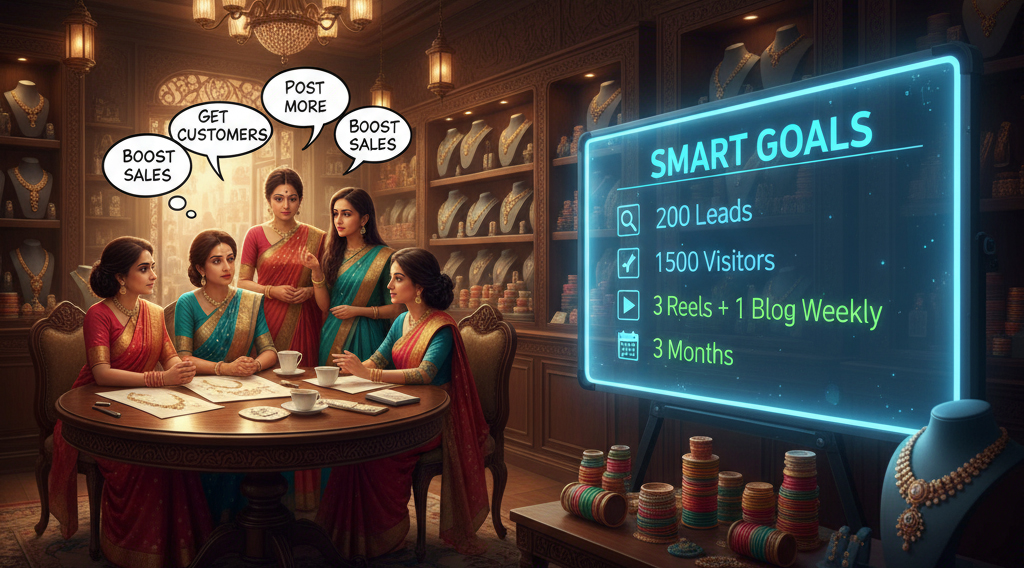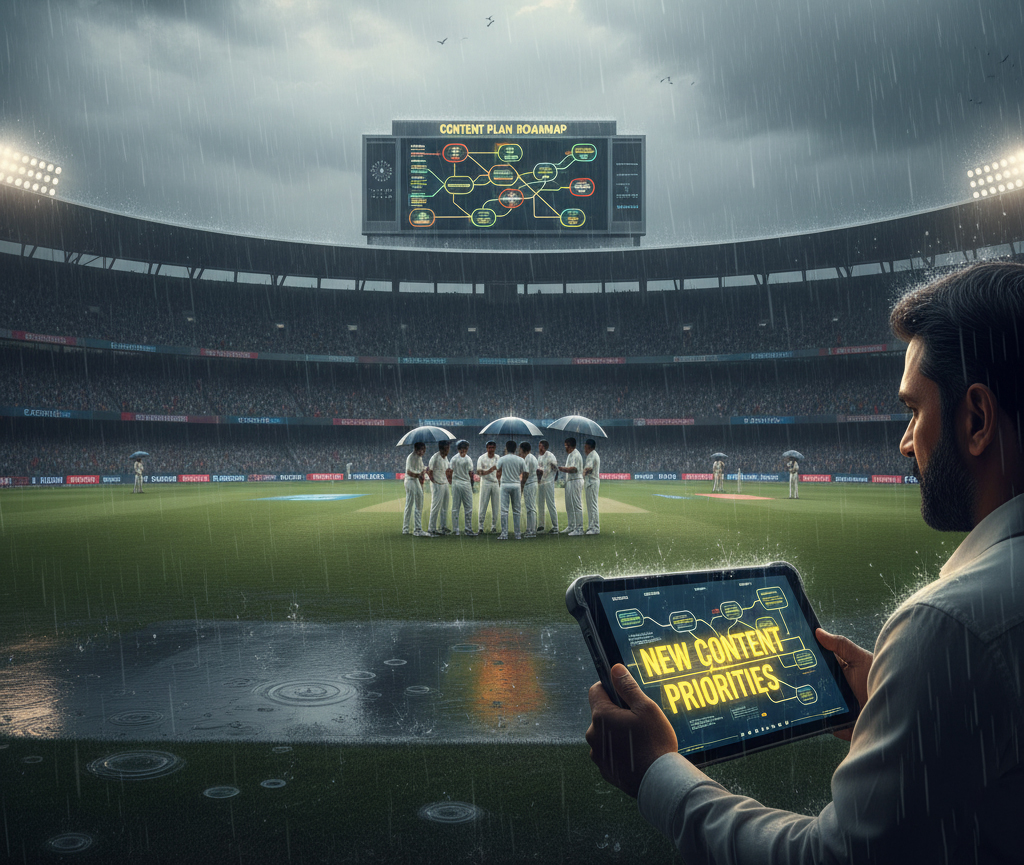Summary: In India’s fast-changing market, long-term content marketing works like compound interest—the more consistently you invest, the bigger your growth. A focused content strategy in India means setting clear SMART goals, running regular content audits (dusting off hidden gems), and aligning content with the buyer’s journey of Indian customers. When brands mix authentic influencer marketing in India with a sustainable digital marketing strategy, they build brand authority, gain steady organic traffic, and prove that consistent content planning always outperforms one-off campaigns.
The Sweet Shop Strategy Lesson

In Kolkata, a popular sweet shop named Madhurima Sweets once decided to experiment with digital marketing. Just before Durga Puja, they put up a lively Instagram post showcasing their special sandesh. The post went semi-viral, people shared it, customers came in, and the shop got a glimpse of the power of content marketing in India. But after that? Silence. For the next two months, not a single update.
The outcome was predictable. Customers who were ready to come back forgot. New followers lost interest. Competitors filled the gap with their own consistent updates.
This story isn’t about sweets—it’s about strategy. Just like putting money once into a savings account won’t build your future, posting content sporadically won’t build your brand. A long-term content plan is like a recurring deposit: the more consistently you contribute, the more you earn over time.
As someone who is HubSpot Academy Content Marketing Certified, I’ve seen this pattern repeatedly in Indian businesses. The difference between brands that fade away and brands that grow into household names is not creativity alone—it’s consistency powered by a clear long-term content strategy in India.
Why Long-Term Content Marketing Matters for Indian Brands

Let’s take the case of LearnFast Academy, a fictional edtech startup in Bangalore. When they launched, the team was enthusiastic. In their first month, they published ten blogs in a flurry of energy—“Top 5 Tips for NEET Prep,” “Why Online Coaching Works,” and so on. But then the rhythm broke. By the second month, content creation had slowed. By the third, it stopped entirely.
Traffic dipped. Leads dried up. The enthusiasm had burned bright, but it hadn’t lasted.
This is exactly where planning acts as a roadmap. A roadmap ensures you don’t just start strong—you keep going. It tells you:
- What to talk about (topics aligned to your brand goals),
- Which formats to use (blogs, reels, videos, podcasts),
- When to publish (a calendar based on seasonality, campaigns, or cultural moments).
Without this roadmap, you’re like a traveler wandering aimlessly, hoping to reach a destination. With it, you’re like a driver on a national highway, confident of every milestone ahead.
And here’s the real benefit: a long-term content plan doesn’t just keep you consistent—it makes you adaptable. Suppose a last-minute opportunity comes up—like a sudden government policy change that impacts your industry—you can slot it into your content calendar without chaos. Your plan gives you both structure and flexibility.
“It’s a long-term game. You have to be consistent.”
During my HubSpot Content Marketing Certification, one lesson struck me the most: content planning isn’t about rigid schedules—it’s about staying aligned with goals while being ready for the unexpected.
Consider this example: A boutique in Jaipur plans its wedding season marketing. The overall goal: 200 new bridal customers in three months. By calculating backward, the team realizes they need 1,500 website visitors, which means publishing at least one bridal-styling blog every week, two Instagram reels showcasing real brides, and a downloadable “Wedding Jewelry Guide” as a lead magnet. Instead of scattered activity, every piece of content is a step toward a measurable goal.
This is where SMART goals come in—Specific, Measurable, Attainable, Relevant, Timely. For LearnFast Academy, a SMART goal could be:
“Increase monthly website visitors from 1,000 to 1,500 within six months.”
See the shift? From “we should write blogs” to “we will increase traffic by 50% in six months.” That’s the power of long-term planning—it transforms enthusiasm into sustained growth.
Setting SMART Goals for Content Marketing Success

Imagine a jewelry brand in Jaipur gearing up for the wedding season. The owner knows that thousands of brides will be shopping for necklaces, bangles, and rings in the coming months. But instead of just saying, “We should post more on Instagram during wedding season,” the team sits down with a clear strategy.
They ask:
- How many new customers do we want?
- How many leads are required to achieve that number?
- What kind of website traffic will generate those leads?
- Which content formats will help us reach them?
This is where SMART goals come in—goals that are Specific, Measurable, Attainable, Relevant, and Timely.
For example, "Generate 200 qualified bridal leads by publishing one weekly blog on wedding jewelry trends, three Instagram reels featuring real brides, and running a free styling webinar before Diwali season—within the next three months."
See the difference? Instead of a vague intention like “let’s post more,” the brand now has a measurable roadmap.
SMART goals act like an exam timetable before the Board exams. Remember how in school, you would plan: Maths on Monday, Physics on Tuesday, Chemistry on Wednesday? The timetable didn’t just organize your studies—it kept you disciplined and ensured every subject got covered. Similarly, SMART goals bring structure and accountability to content planning.
Another example: A startup edtech company might set a goal like, “Increase monthly website traffic from 5,000 to 7,000 within six months by creating a 10-part blog series on NEET preparation, repurposing them into YouTube shorts, and collaborating with two education influencers.”
These goals are clear, tied to timelines, and directly linked to business growth. They also help the team measure success: if they fall short, they can analyze whether the content itself needs improvement or whether the distribution strategy needs tweaking.
When your marketing goals align with your overall business goals, every piece of content becomes purposeful. It’s no longer just a blog or a reel—it’s a step closer to actual sales, brand awareness, and customer trust.
Content Audit Examples: Dusting Off the Old Almirah

Every Diwali, most Indian households go through the same ritual—dusting off the old almirah. In the process, we often stumble upon forgotten treasures: a silk saree from a wedding years ago, a piece of jewelry tucked away in a box, or even old photos that bring back memories.
A content audit works exactly like that. Businesses often create content in bursts—blogs written by past teams, brochures designed years ago, sales decks hidden in folders, or videos uploaded on YouTube that no one remembers. Over time, these assets scatter and lie unused, like those forgotten sarees and ornaments.
The truth is, many Indian startups and SMEs don’t even know how much content they already have. They just keep producing new material while the older gems gather dust. A proper content audit can save hours of work and uncover opportunities that were hiding in plain sight.
Here’s what a content audit involves (based on proven frameworks I learned during my HubSpot training):
- Content Title – What is it called?
- Buyer’s Journey Stage – Awareness, Consideration, or Decision?
- Lifecycle Stage – New lead, active customer, or loyal promoter?
- Format – Blog, eBook, video, reel, podcast, etc.
- Target Persona – Who is this for? A student, a bride, a parent, a CEO?
- Topic & Notes – Any context that explains how it can still add value.
For example, an edtech company might find an old PDF on “How to Manage NEET Stress” in their archives. With some updates, this can be repurposed into a modern blog, an infographic, or even an Instagram carousel.
But auditing doesn’t end there. You also need to look ahead with an event-based audit. Just as families prepare for Diwali, Holi, or Eid months in advance, brands should prepare for business events, seasonal spikes, and product launches.
An event audit usually includes:
- Monthly priorities (e.g., festive season campaigns, product launches).
- Initiative overview (what’s happening and why).
- Theme or topic (e.g., “Preparing for Pujo 2025”).
- Blog or video topics that support the initiative.
- Campaign tie-in (e.g., free eBook or offer connected to the posts).
Consider a restaurant chain in Delhi. By auditing their upcoming events, they realize that World Food Day is approaching. Instead of missing the moment, they plan a blog series on “Healthy Eating,” tie it with a video of their chef making millet dishes, and connect it to an offer on their app. The result? A small event becomes a big content opportunity.
A good audit ensures you’re not reinventing the wheel every month. You’re recycling what’s valuable, planning for what’s coming, and stitching everything into one bigger strategy. Just like cleaning your almirah before Diwali ensures you use what you already have before buying new, a content audit ensures every piece of your effort adds up to your brand’s long-term library.
Mapping the Buyer’s Journey for Indian Businesses

Every purchase is a journey. Think about the last time you bought a smartphone. You didn’t just walk into a store and pick the first model you saw. First, you Googled “best phones under ₹30,000.” Then you compared reviews, checked YouTube unboxings, and finally went to a shop or e-commerce site to make the purchase.
That’s the buyer’s journey in action:
- Awareness – You realize you have a need or problem.
- Consideration – You explore possible solutions.
- Decision – You pick the brand or product that feels right.
Now, let’s place this in an Indian context with a relatable persona.
Meet Ananya, a 32-year-old IT professional in Bangalore. She’s married, has a 4-year-old daughter, and juggles career with parenting.
- Awareness Stage: Ananya notices her child throwing tantrums and struggling with preschool tasks. She searches Google for “how to handle toddler tantrums” and “best preschools near me.” Content that works here: parenting blogs, educational YouTube videos, and quick social posts with tips.
- Consideration Stage: After reading, Ananya realizes Montessori education might be the answer. She looks for comparisons—“Montessori vs. traditional schooling” or “benefits of Montessori method.” Content that works here: eBooks, checklists, or webinars explaining the method and its benefits.
- Decision Stage: Now Ananya is ready to choose a school. She wants specifics: fees, locations, admission process, and credibility. Content that works here: testimonials from other parents, free consultations, or a “visit our campus” video tour.
This same logic applies across industries. Whether it’s a bridal jewelry brand in Jaipur, a real estate firm in Gurgaon, or a food delivery startup in Pune—understanding your customer’s journey lets you create content tailored to each stage.
Think of it like a train journey:
- Awareness = the boarding station (where the passenger realizes they need to travel).
- Consideration = the journey itself (comparing routes, trains, or timings).
- Decision = the destination (finally reaching where they want to go).
When you map your content to these stages, you’re no longer shouting into the void. You’re walking alongside your customer—answering their questions, earning their trust, and nudging them closer to choosing you.
"Every Indian customer moves through awareness, consideration, and decision in their own way. If your content doesn’t walk beside them at each stage, someone else’s will.”
For example, a jewelry brand could publish: “10 Bridal Jewelry Mistakes to Avoid” (awareness), “Gold vs. Diamond for Weddings: Which Suits You Best?” (consideration), and “Why 200 Jaipur Brides Chose Us in 2024” (decision).
By aligning your content with the buyer’s journey, you don’t just market—you build relationships. And when Indian customers trust you, they don’t just buy once, they bring their friends and family too.
Influencer Marketing in India: Beyond Social Media Likes

When most people hear the term influencer marketing, they picture Instagram celebrities posing with products, or YouTube stars unboxing the latest gadgets. But real, sustainable influencer collaboration is more than a quick shoutout—it’s about building relationships that strengthen your brand’s SEO, authority, and credibility.
Take the case of a jewelry brand in Kolkata preparing for Durga Puja. Instead of paying a mega-celebrity for one flashy Instagram post, they invite a regional fashion blogger to their workshop. The blogger interviews the artisan goldsmiths, shares behind-the-scenes photos, and later includes the brand in her blog on “Saree and Jewelry Styling for Pujo.”
Result?
- The brand gets an authentic backlink from the blogger’s website.
- Local readers see the jewelry as part of a cultural story, not just a product ad.
- The collaboration feels organic, not transactional.
This is exactly why influencer collaboration is powerful—it goes beyond likes to create long-term digital footprints.
Why Does This Work?
Search engines like Google reward authority and relevance. Two of the biggest factors for ranking are:
- Links – Who is pointing to your content?
- Content – Is it valuable enough to be referenced by others?
Influencers, bloggers, journalists, and podcasters are part of the small group of people who actually create content that generates links. If your brand appears in their content, your authority rises.
Forms of Collaboration That Work Best:
- Contributor Quotes: Reach out to niche experts for one-line insights in your article. When you publish, they’re invested in sharing it too.
- Expert Roundups: Collect thoughts from multiple influencers on one topic—“10 Indian Designers Predict 2025 Bridal Trends.”
- Guest Blogging: Write for other sites in your industry. A Delhi interior brand writing for a real estate blog, for instance, gains backlinks + new audience exposure.
- Interviews & Podcasts: Invite industry experts to a conversation. Almost everyone is happy to be interviewed, and in return, they’ll share your content.
Example: An edtech company in Pune collaborates with 5 popular teachers on Instagram. Instead of a one-time shoutout, they co-create a free webinar on “Last-Minute JEE Prep Hacks.” The teachers promote it, students join in, and the brand gains trust + long-term search visibility because the webinar recording lives on their site.
Think of influencer collaboration like Indian hospitality. If you invite someone to your home and share food with them, they’re more likely to invite you back. The same happens digitally—when you include people in your content, they include you in theirs.
At the end of the day, influencer collaboration is not about asking, “Who will post about me?” but rather, “Who can I create something valuable with?” When done right, it turns influencers into partners—and partners into promoters.
Staying Aligned with Your Digital Marketing Strategy

No matter how carefully you plan, real life always has other ideas. A cricket team may walk onto the pitch with the best batting order, only to face a sudden rain interruption. What happens then? They don’t abandon the match—they adjust to Duckworth–Lewis, reshuffle their strategy, and keep playing to win.
Content planning works the same way. Obstacles are inevitable:
- A campaign delayed because a product launch got pushed back.
- A sudden government policy change that shifts your industry’s focus overnight.
- A competitor running an unexpected discount blitz.
- Or, something as simple as your team being stretched thin.
Here’s where a long-term plan becomes your anchor. It doesn’t eliminate challenges, but it helps you regain alignment faster. With a clear roadmap, you can re-prioritize instead of panicking.
"I treat content creation as a business and in business consistency is very important."
Example: A Delhi-based fintech startup planned a year-long blog calendar around investment tips. Midway, new RBI regulations changed the way digital lending apps operated. Instead of scrapping their entire plan, the team slotted in new content around “What RBI’s Latest Guidelines Mean for Borrowers,” while keeping their broader financial literacy series intact. The pivot was smooth because they had structure in place.
Another benefit of planning is bandwidth management. Without a roadmap, every request feels urgent. With one, you can see what’s essential, what can wait, and what should be dropped. It protects your team from burnout while keeping the business on track.
Think of it like running a marathon. Sprinters may burn out quickly, but marathoners pace themselves, adjust when tired, and keep their eyes on the finish line. A long-term content plan doesn’t guarantee a smooth road, but it ensures you always know which direction to run—no matter what hurdles appear.
Building Brand Authority Through Consistent Content Planning

Every blog post, every reel, every podcast you publish is like adding one more book to your library. At first, the shelves look half-empty. But as months pass and contributions add up, you suddenly realize you’re no longer running a one-room collection—you’re running a full-fledged library of knowledge and stories.
That’s the real magic of a long-term content strategy. It doesn’t shout for attention; it earns it, piece by piece, over time.
Think of Rabindranath Tagore’s body of work. No one remembers him for just one poem or one story. His legacy was built across decades, each piece adding to a larger narrative. In the same way, Indian businesses that consistently create and align their content don’t just market products—they build authority, trust, and memory in the minds of their audience.
So the question isn’t whether you should plan long-term. The question is: what story are you building for your brand’s library?
And remember—this isn’t just theory. As a Content Marketing professional, I’ve seen how planning, auditing, and collaborating can transform scattered efforts into a strategy that compounds like interest in a bank account.
In the short term, a social media post might bring likes. But in the long term, a content library brings loyalty. And in a marketplace as competitive and dynamic as India’s, loyalty is the difference between being remembered—or forgotten.


